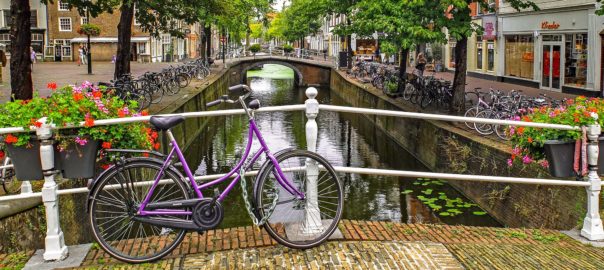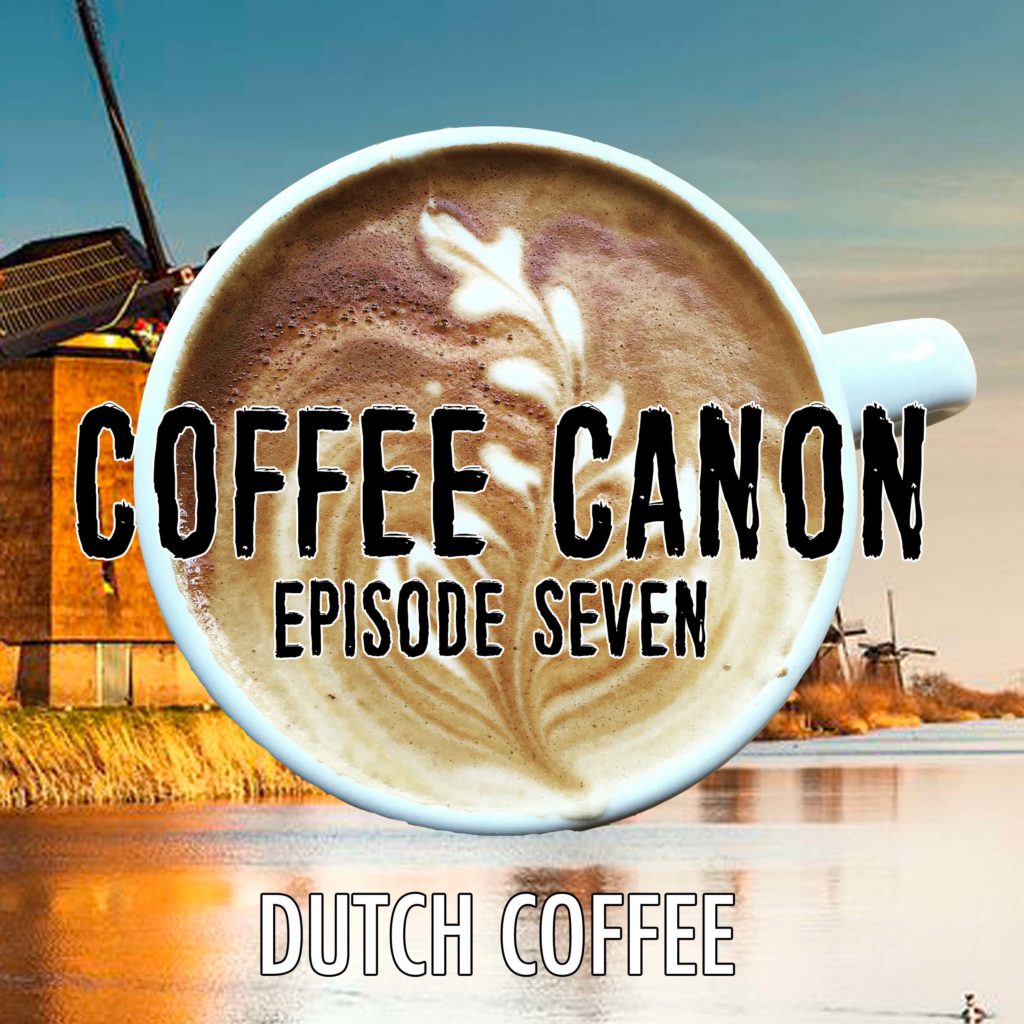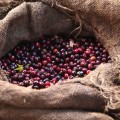The Netherlands is only about 1,000 miles from the Arctic Circle, making farming difficult. And yet, Dutch culture is intimately tied to coffee culture and history. Many of the biggest events that turned coffee from a novelty to a commodity happened because of the Dutch. On this episode of Coffee Canon, we explore the stories and people that took coffee from Europe to the Caribbean and South America.
Episode Seven Sources:
- Dutch coffee history
-
- “History of Dutch Coffee,” dutch-coffee.nlhttps://www.dutch-coffee.nl/history-of-dutch-coffee/
- “Dutch Coffee History And Culture,” Know Your Grinder, by Dave https://knowyourgrinder.com/dutch-coffee-history-and-culture/
- “The History of Coffee,” National Coffee Association, http://www.ncausa.org/About-Coffee/History-of-Coffee
- “The History of Coffee,” Go Coffee Go, by Professor Peaberry https://www.gocoffeego.com/professor-peaberry/history-of-coffee/1700
- “Petty Theft Brought Coffee to America,” Modern Nation, by Josh Hrala http://modernnotion.com/how-an-act-of-petty-theft-brought-coffee-to-america/
- “All About Coffee,” by William H. Ukers, 1922
- Coffee drinking statistics
-
- “Here Are the Countries That Drink the Most Coffee—the U.S. Isn’t in the Top 10,” The Atlantic, by Roberto A. Ferdman https://www.theatlantic.com/business/archive/2014/01/here-are-the-countries-that-drink-the-most-coffee-the-us-isnt-in-the-top-10/283100/
- “Mapped: The countries that drink the most coffee,” The Telegraph, by Oliver Smith http://www.telegraph.co.uk/travel/maps-and-graphics/countries-that-drink-the-most-coffee/
- Greenhouses
-
- “This Tiny Country Feeds the World,” National Geographic, by Frank Viviano https://www.nationalgeographic.com/magazine/2017/09/holland-agriculture-sustainable-farming/
- “Way Back When: A History of the English Glasshouse,” Hartley Botanic, by
- Wikipedia
-
- The History of Coffee, https://en.wikipedia.org/wiki/History_of_coffee
- Gabriel de Clieu, https://en.wikipedia.org/wiki/Gabriel_de_Clieu
- Greenhouse, https://en.wikipedia.org/wiki/Greenhouse
- Dutch East India Company, https://en.wikipedia.org/wiki/Dutch_East_India_Company
- Coffee production in Martinique, https://en.wikipedia.org/wiki/Coffee_production_in_Martinique
- Music
-
- Podington Bear, The Confrontation – http://freemusicarchive.org
- Podington Bear, Threshold – http://freemusicarchive.org
- Podington Bear, Aim Is True – http://freemusicarchive.org
Episode Seven Transcript:
The primary thing that fascinates me about coffee’s history is how un linear it is. What I mean by that, is that coffee’s discovery and subsequent spread from Africa and the Middle East to Europe and beyond didn’t happen in any of the ways one might expect. When we look at history, it’s easy to forget that we’re peering into real snapshots in time – actual events that transpired because of the actions and choices people made.
In movies, we know that the plot is going to move forward in a predictable way. That’s one of the reasons why I love films by the Cohen brothers – their stories aren’t strictly grounded in reality, but the way the plot advances is. Characters make half-thought through decisions that sometimes lead to dead ends. Some characters never see how their actions affect the larger story. People die unexpectedly.
In past episodes of this podcast we’ve seen how individuals’ actions have had rippling impacts on global coffee culture. From the 16th century Ottoman Empire to 1950s Italy, we’ve discussed stories that show how coffee’s spread and adoption wasn’t some natural occurring phenomenon, but instead the result of a handful of dedicated risk-takers.
Today’s stories are going to put those to shame. Industry-changing heists, royal theft, knife fights, and even pirates – this episode’s got it all. And connecting each of these stories is the Dutch.
I’m Colin Mansfield, and welcome to Coffee Canon.
Dutch culture is intimately tied to coffee drinking. According to 2014 data from Euromonitor, people from the Netherlands drink 2.4 cups of coffee per day. That may not sound like much on its face, but consider this: that’s on par with the US, the UK, Spain, and France combined. Another way to measure coffee drinking habits is in kilograms consumed per person per year. A 2017 article from The Telegraph placed the Netherlands at number 5 with 8.4kgs per person per year, below Finland, Norway, Iceland, and Denmark. The U.S. isn’t even in the top 20.
According to sources familiar with the matter (and by that I mean a guy I work with who’s from the Netherlands) It’s not uncommon for a Dutch working-person to drink a cup before work, immediately upon arriving to work, at midday, and sometime towards the evening. And from what I’ve gathered, the Dutch aren’t extremely picky about their coffee – they enjoy specialty coffee, but will happily drink Nespresso if that’s what’s available.
The Netherlands is only about 1,000 miles from the Arctic Circle, making farming difficult. In as early as the 16th century, the Dutch began experimenting with the concept of greenhouses, also called glasshouses. They were probably the first European country to do so, closely followed by England. These early greenhouses were difficult to close up at night and winterize – they just didn’t provide adequate and balanced heat to consistently grow food in a sustainable way.
In the 17th century, a French biologist named Charles Lucien Bonaparte – the nephew of Emperor Napoleon – built the first practical greenhouse. He did it in Holland. Later in the 17th century, the Netherlands added greenhouses to their Hortus Botanicus – one of the oldest botanical gardens in the world. These greenhouses became the home of many varieties of foreign plants ill-suited to the Netherland’s colder temperatures – one of which was a single coffee bush that had been stolen from Yemen.
If you remember, last episode we briefly discussed the guy who stole that coffee bush; his name was Pieter van den Broecke. He was a Dutch merchant who worked for the Dutch East India Company in the early 1600s – a formative time for the company. See, the Dutch East India Company was founded in 1602 as a means for the Dutch government to enact a monopoly on the spice trade in their country. The company came up with a novel idea – they issued bonds and shares of stock to the general public, allowing individual citizens to own a piece of the company. If that sounds familiar, it’s because that’s how publicly traded corporations run today. In fact, the Dutch East India Company was the first formally listed public company and first corporation to ever be listed on an official stock exchange.
It was in this environment of corporate growth and opportunity that Pieter van den Broecke sought to make his living. And he did well for himself – at one point in 1611 he transported 65,000 pounds of ivory to Amsterdam from a captured Portuguese ship. At one point during his career he was made the Dutch East India Company’s manager in Dutch Suratte – a colony that is now in present-day India, and later the head of the Banda Islands in Indonesia. Descendants of van den Broecke live on Banda to today.
His greatest contribution to the world – the coffee plant he stole from Yemen – was only a small vignette of his dramatic career. It happened in 1614 when he visited Yemen’s primary port, Mocha. As you might remember, Yemen had banned the sale of live coffee bushes in an effort to keep their cash crop a monopoly. Van den Broecke stole one of these plants and transported it back to Amsterdam. It was planted in the Botanical Gardens there, where it remained largely untouched for 100 years.
In the years following Pieter van den Broecke’s heist, coffee did find its way to Europe via trading. Coffee shops quickly gained popularity in metropolitan centers like Italy, England, France, and Holland. But as far as I can tell, the only live coffee plant in Europe during this time was the one planted in the Amsterdam Botanical Gardens. Greenhouse or no, coffee simply was not successfully grown as a crop in Europe. It was a treasured novelty, which helps explain the events that transpired in 1714.
That year, King Louis XIV of France visited Holland. The Mayer of Amsterdam presented the King with a gift during his visit – a coffee seedling taken from the Amsterdam Botanical Gardens. The King recognized its value and had it planted within the Jardin des Plantes – the royal botanical gardens – in Paris. It was a showpiece – a token of friendship between nations. According to once source, the plant was received with a ceremony led by the professor of botany in charge.
Ten years later, around 1724, coffee’s propagation took its next big leap. Its hear that we have to dip back into the realm of legend and hearsay – not because the events aren’t recorded, but rather because they’re recorded by the man who carried them out. History is written by the victors, and the victors tend to write themselves as the heroes. In this case, our “hero” is a French naval captain named Gabriel de Clieu. He recorded the events we’re about to discuss in 1774 in a letter written to “The Literary Year,” a French periodical based in Paris. The letter was published, and is the primary source for the events that follow. I couldn’t actually read the periodical – it’s in French, and I couldn’t find any English translations, but a summary of his events was published in the 1922 book “All About Coffee” by William Ukers. It’s an entertaining read and dives deeper into coffee’s propagation – if you’re interested in checking it out, take a look at my show notes for the Google Books link.
de Clieu was serving as captain of infantry on Martinique – an island located in the eastern Caribbean Sea. Somewhere between 1720 and 1724 personal affairs took de Clieu to Paris, and while there he conceived an idea to bring coffee plants back to the island. It’s not clear why he wanted to do this – maybe he recognized the economic possibilities of growing a rare crop in a new place. The problem was that there was absolutely no way the French government was going to let him take coffee plants on the journey back to Martinique. The likelihood of coffee seedlings surviving the journey was incredibly small – and remember, these coffee plants represented goodwill between nations – they weren’t actually supposed to produce a coffee crop. What de Clieu needed was an inside man – someone willing to help him steal one or more coffee plants. The man who ended up helping him was a royal physician named M. de Chirac, but how de Clieu enlisted his help requires a little interpretation.
In Ukers’ book “All About Coffee,” he writes, “His first difficulty lay in obtaining several of the plants then being cultivated in Paris, a difficulty at last overcome through the instrumentality of M. de Chirac, royal physician, or according to a letter written by de Clieu himself, through the kindly offices of a lady of quality to whom de Chirac could give no refusal.” Some unsubstantiated accounts I’ve read reference de Clieu having seduced this lady to help him – but the term “lady of quality” isn’t a euphemism. It literally means an upstanding woman. The best possible interpretation is that de Clieu found a woman willing to help him convince the royal physician to commit the theft. My sources indicated that any other explanation is reaching, at best.
M. de Chirac, the royal physician, stole some of the coffee plants, and soon after de Clieu departed on his journey back to Martinique. de Clieu took great care to ensure the plants survival on the journey back – apparently he even went so far as to install a box covered with a glass frame in order to “absorb the rays of the sun and thus better to retain the stored-up heat for cloudy days.” The survival of this plant was obviously important to Gabriel de Clieu.
In his account that was later published, he writes about four perilous events, any one of which could have ruined any chance of the coffee plant surviving its journey.
First, one of the young officers on board sought to claim the plant for himself. de Clieu relates the confrontation, writing, “It is useless to recount in detail the infinite care that I was obliged to bestow upon this delicate plant during a long voyage, and the difficulties I had in saving it from he hands of a man who, basely jealous of the joy I was about to taste through being of service to my country, and being unable to get his coffee plant away from me tore off a branch.” One dramatic account, colorfully written but lacking sources, talks about this man pulling a dagger, and de Clieu defending the plant with a sword.
The second event that nearly ruined the voyage was an attack by pirates. Unfortunately there’s no details recorded about how the ship and its crew managed to escape the pirates – but every single version I found references this having happened. In “All About Coffee” Ukers writes, that they “narrowly escaped capture by a corsair of Tunis.” Another version I found talks about the crew fending off the pirates for a full day before escaping. Regardless of how it happened, I think its safe to say that it did actually happen. Both the crew and the coffee plant survived.
Then there was the storm. Apparently it was bad – a “violent tempest” by some accounts. During the storm, the glass box that de Clieu had built to house the coffee plants shattered – but the plants themselves survived.
The fourth, and final event that almost ruined the voyage wasn’t as exciting as pirates or storms, but it was just as dangerous – lack of water. After the storm, almost the entire supply of drinking water was exhausted. What was left was rationed amongst the people on board. At this point I think most of us would let the coffee plants die – I know I would. But not Gabriel de Clieu. In his written account of the voyage, de Clieu talks about using portions of his water rations specifically to keep the seedlings alive. He writes, “Water was lacking to such an extent that for more than a month I was obliged to share the scanty ration of it assigned to me with this my coffee plant upon which my happiest hopes were founded and which was the source of my delight. It needed such succor the more in that it was extremely backward, being no larger than the slip of a pink.” I’m not actually sure what a “slip of a pink” is…but I think de Cleiu’s meaning is clear: he hadn’t come this far only to let the coffee seedlings die.
Finally, the ship arrived at Martinique. The next step, as far as de Clieu was concerned, was to make sure the coffee was planted and protected. He writes about the steps he took, saying, “my first care was to set out my plant with great attention in the part of my garden most favorable to its growth. Although keeping it in view, I feared many times that it would be taken from me: and I was at last obliged to surround it with thorn bushes and to establish a guard about it until it arrived at maturity…this precious plant which had become still more dear to me for the dangers it had run and the cares it had cost me.”
The first harvest from the coffee seedlings came in 1726, and the second in 1727. The coffee plants loved the weather in Martinique and began to spread rapidly. de Clieu writes, “Success exceeded my hopes. I gathered about two pounds of seed which I distributed among all those whom I thought most capable of giving the plants the care necessary to their prosperity. The first harvest was very abundant; with the second it was possible to extend the cultivation prodigiously, but what favored multiplication, most singularly, was the fact that two years afterward all the cocoa trees of the country, which were the resource and occupation of the people, were uprooted and totally destroyed by horrible tempests accompanied by an inundation which submerged all the land where these trees were planted, land which was at once made into coffee plantations by the natives. These did marvelously and enabled us to send plants to Santo Domingo, Guadeloupe, and other adjacent islands, where since that time they have been cultivated with the greatest success.”
The event de Clieu referenced in regards to the cocoa trees was a documented earthquake in 1727. By 1777, there were between 10-20 million coffee plants in Martinique. One source I found stated that the coffee grown in Martinique in the years that followed exceeded what was drank by the entire country of France. What’s more, not only were coffee trees shipped to Santo Domingo and Guadeloupe, as de Clieu stated, but all across the Caribbean and eventually to South America. Guatemala, Brazil, Nicaragua, Colombia – all the coffee powerhouses we know and love today – all of them have Gabriel de Clieu to thank. And as for de Clieu, well – where would he be without the Dutch?
As we talked about at the beginning of the episode, today the Dutch love coffee – it’s a significant part of their daily ritual and culture. Interestingly, another love they’ve held on to since the 16th century is greenhouses. In September of 2017 National Geographic published an incredible article called “This Tiny Country Feeds the World.” Its tagline is: “The Netherlands has become an agricultural giant by showing what the future of farming could look like.” I highly recommend checking this article out – its full of beautiful pictures and excellent journalism – classic National Geographic. The article talks about how the Netherlands is home to these incredibly massive greenhouse farms that have made strides in vegetable production most people would think impossible.
About two decades ago the Dutch made a national commitment to sustainable agriculture, setting their goal at “twice as much food using half as many resources.” One farm that the author of the article interviewed has reduced their dependence on water for key crops by as much as 90%. As measured by value, The Netherlands is the globe’s number two exporter of food, second only to the US. All of this, in a country without access to nearly every resource commonly considered necessary for large-scale agriculture. To make things even more interesting, The Netherlands is a global leader in exports of a crop that typically is only grown in warm, sunny climates: the tomato. By yield per square mile, The Netherlands is far-and-away number one in the world, bringing in 144,352 tons per square mile. Compare this to, say, China – a massive country who’s actual tomato yield far surpasses The Netherlands (58 million tons vs. about 1 million from the Dutch), but their farmable land mass for tomatoes is about 3,800 square miles – compared to the The Netherlands 6.9 square miles. This makes China the least efficient tomato farming nation in the world, coming in at only 15,000 tons per square mile. Again, The Netherlands’ number was 144,352 tons per square mile.
The Dutch accomplish this by utilizing space-saving growing methods that aren’t by any means new – much of what they’ve implemented goes back to 10,000 years ago in the Fertile Crescent. Rather than relying on heavily regulated GMO seeds, The Netherlands uses molecular breeding to produce some of the most reliable seeds in the world. And they’re a world leader in this area too – Dutch firms had close to $1.7 billion worth of seed exports in 2016.
Notably absent from this article was any discussion about coffee. The Dutch are focused on food and seed exports for crops necessary to sustain human life – coffee, as much as I love it, simply doesn’t fit into their vision for the future. And honestly, the elements that create great coffee – specific temperatures, soil composition, and altitude, probably aren’t achievable in a greenhouse environment. That said, it’s wild to think that the technology used to keep Pieter van den Broecke’s stolen coffee plants alive in the Amsterdam Botanical Gardens in 1614 – greenhouses – is the same technology being used to push the global food market forward 400 years later. And, as always, the Dutch are leading the way.
Thanks for listening to Coffee Canon. I’m your host, Colin Mansfield, and I’m excited to announce a new way to listen to the podcast. It’s called Anchor, and it’s an app you can download on your Android Phone or iPhone. Anchor makes it possible to record your own podcast, if that’s what your into, but it also provides a great user interface for listening to podcasts and audio shows you love. Check it out at anchor.fm/coffeecanon.
Have an excellent week, and please watch out for coffee pirates.
Podcast: Play in new window | Download
Subscribe: Apple Podcasts | Android | Stitcher | RSS




